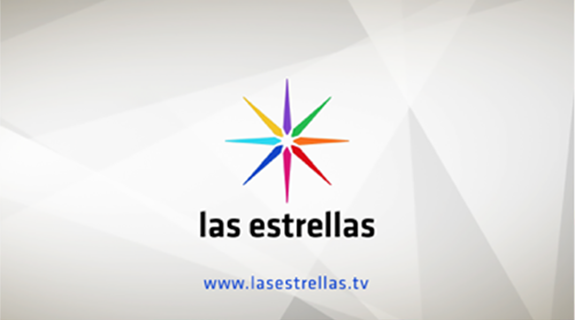Mexican network Canal de las Estrellas (Channel of the Stars) has refreshed its brand with a new name and look that turns its very audience into Stars, while offering them a unique cross-platform experience.
The channel, part of Televisa, began to explore the idea of a relaunch based on several studies within the research project México Emergente. One of these reports, México Rifado — carried out by De la Riva, a leading market research company in Mexico — showed that Mexico’s emerging generations are not necessarily entirely represented by the younger population.
Mauricio Carrandi, vice president of image and advertising at Televisa, says the network decided to debut its rebrand a little early, unveiling it on August 22 to coincide with some programming changes at the network. Those included Denise Maerker taking over for Joaquín López-Dóriga, who had hosted the network’s nightly newscast for 16 years, as well as the addition of new entertainment programs.
The first step in the rebranding process was to organize all of the research, a task entrusted to Lee Hunt, an internationally renowned brand strategist, who also played a key role in developing the strategy.
According to Carrandi, the research came to two conclusions. First, that the stars are one of the channel’s cornerstone concepts, “not only because we have Mexico’s most popular cast of in-house talent, but also because we hold broadcast rights to seven important Mexican soccer teams, and have some of the best sports announcers and news anchors.”
Second, Televisa discovered that the word channel refers to television of the past. It wanted to “move forward from the idea of a linear channel to reposition it to what it really is, a content distribution platform for the pay-TV as well as the digital world,” says Carrandi.
All of this opened up the possibility of rethinking the name.
“El Canal de las Estrellas is long and cumbersome,” says Hunt. “But we learned from research that our viewers have great affection for it. So we looked at the heart of the name, the stars, and realized that we just needed to reinvigorate it.”
It was at this point that Mauricio Carrandi went deeper into the different meanings of “the stars,” as they apply to Televisa.
Hunt explained that Carrandi defines them as “celestial bodies that people have used for thousands of years to determine their direction and destiny. Stars guide us, help us to make sense of the world, and point to the future.”
The road led to the channel’s rename from Canal de las Estrellas to simply Las Estrellas (The Stars).
“Changing the name without changing it was a unique challenge, given the powerful emotional connection it has with its audience,” explains Elaine Cantwell, executive creative director at Broadway Video, “but the answer came from the name itself.”
Cantwell, who led the creative team that worked on the rebrand, says this has helped maintain the legacy of the brand, “moving it forward, placing it in today’s multi-platform entertainment environment.”

The next step was to create a new logo that “manifests the name in a fresh and contemporary way,” says Cantwell. “It was important to reflect Mexican culture, home to some of the most innovative and influential art and design.”
She says hundreds of logos were produced to get to the final version, “an eight-pointed multi-colored star that represents new beginnings and stresses the concept of new horizons: a new time, a new place, a new era for Las Estrellas.”
The warm palette and the curvilinear font choices reinforce that “the viewer is part of this close, connected family, ‘Las Estrellas,’” says Cantwell, while the diversity and variety of programming is communicated “through rich and vibrant color.”


To incorporate the brand into the programming, Televisa uses the prefix with before the stars to encourage viewers to engage with the new phrase, says Carrandi. For example, a telenovela is presented with the phrase get emotional with the stars. The entire concept is then converted into a hashtag.
The next stage was to create a campaign featuring behind-the-scenes clips with the network’s most glamorous personalities.
“We wanted to introduce our celebrities in a very dynamic and informal way,” says Carrandi. “The stars have positive features, but they can also be distant. In these pieces, we intended to put a telescope in front of our talents and bring them closer to the audience.”
Of the many promos created for the rebrand, Una nueva historia para nuestro canal (A new story for our channel), stands out.
The network created 60 audiovisual pieces as part of the overall campaign that will run until 2017.
The network’s online platform also has been redesigned, including all of the brand’s digital extensions as well as its exclusively created content.
Overall, Las Estrellas’ rebrand aims at a modern, proactive Mexican public—and not just millennials—“without neglecting our female audience, whom we love and respect,” says Carrandi.
This emerging Mexico wants change and the country’s evolving population “does not expect anyone to do it for them,” says Hunt, based on the results of the previously mentioned study. “Mexicans want to take control of their own lives. Mauricio Carrandi and his team realized that our brand could be a part of that emerging attitude.”
The relaunch of Las Estrellas promises three things, says Hunt.
The first is to “become the best of who we are. We are the most trusted stars on television and that includes our viewers,” he said.
The second is that the channel “guides us through life, including the best daytime programming.”
Finally, “it helps us make sense of the world and point to the future, since our news programming does not just report what is happening, but helps you to understand it.”
RELATED: El Luminoso Rebrand del Canal Las Estrellas de Televisa Apunta al Estrellato (Version Español)
Tags:













































__twocolumncontent.jpg)











